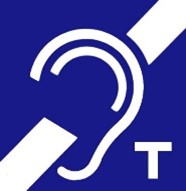
Hearing Loops
Hearing Loops are designed to assist those who use hearing aids or have cochlear implants to hear better. Hearing loops was piloted at the Fremont BART Station in 2017 that was successful and BART continues to add hearing loops throughout the BART System.
TDD
There is at least one Telecommunications Device for the Deaf (TDD) in each BART station.
White Courtesy Phones
All BART Stations have public white courtesy telephones near the elevator locations and through out the station at all levels which will connect to a BART Station Agent or connect to the BART’’s Operating Central Center (OCC).
Escalators
All BART stations have escalators. Generally, the escalators operate in the direction of main passenger flow, which varies depending on the time of day and location. Where possible, escalator service is provided in both directions. To ensure your safety and the safety of others, be sure to hold on to the handrail while using the escalators. Wheelchairs are not allowed on the escalators. To check the status of escalator operation at any station, call the BART Transit Information Center.
Parking
Stations with parking have specially designated disabled person (DP) parking spaces. If you're using a DP parking space at the station that has daily parking fees, you are required to pay the established parking fees at times when those fees are in effect. Check the parking section for more details.
At the Platform
Stand behind the wide yellow strip of textured rubber tiles that runs along the length of all BART platforms. These tiles can be detected with a cane or foot. Black rubber tiles are used to mark the approximate location of train doors when the train pulls into the station. In some stations, an extra row of black tiles marks the entrance to the two middle cars of the train. Exact door locations may vary. Do not approach the train until it comes to a complete stop.
Elevators
All BART stations have accessible elevators. In some stations you may need to use two different elevators to get from the street to the train platform level. If you arrive at a BART station and are unable to enter or exit the station because the elevator is not working, contact the Station Agent. They will help you enter or exit in another way if possible, or refer you to an alternate means of transportation such as a bus or paratransit.
If you find out in advance that an elevator is not working at the station you want to go to, call the BART Transit Information Center to find out what transit alternatives are available to you. To check the status of elevator operation at any station, call (510) 834-LIFT or (888) 2-ELEVAT. In case of fire, do not use the elevators.
You can also sign up for elevator status alerts.
If you need to communicate with the Station Agent while inside the elevator, use the emergency telephone. If the Station Agent does not answer within 90 seconds, your call will be directed to BART Central Dispatch. If the emergency telephone is picked up for at least two minutes but there is no voice communication, BART will treat this as a call for assistance. This ensures that help is available to elevator passengers even if they are unable to speak.
Seating
There is priority seating to the left of the door on all trains for seniors and people with disabilities. All trains can also accommodate wheelchair users to the right of the doorways.
